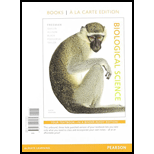
Introduction:
The spiracles are the valve-like structures present in the exoskeleton of insects, which can be opened or closed as per the requirement.
Answer to Problem 1TYK
Correct answer:
The spiracles close off the tracheae to minimize the water loss in the insects.
Explanation of Solution
Explanation/Justification for the correct answer:
Option (d) is given that the function of the spiracles in the insects is to close the tracheae to regulate the loss of water from the body. Insects have adopted a different type of respiratory system called the tracheal system. The insects have tracheae (air-filled tubes) located within their bodies. These tubes are connected to the external environment through spiracles. The air moves into the spiracles from the environment. The air then moves inside the insect’s body through the tracheae. The closing of spiracles is controlled by the CNS (central nervous system) as well as the
Explanation for incorrect answers:
Option (a) is given that the spiracles dilate and constrict during flight or other types of movement, functioning as a breathing mechanism in the insects. The spiracles do not dilate and constrict during flight or other movements of the insect only. They dilate and constrict even when the insect relaxes. So, it is a wrong answer.
Option (b) is given that the spiracles open into the body cavity, allowing direct contact between hemolymph and tissues in the insects. The spiracles do not open into the body cavity. These are the openings present on the outer surface. So, it is a wrong answer.
Option (c) is given that in the insects, the spiracles are thin and highly branched, offering a large surface area for the exchange of gases. In the insects, the trachea is highly branched structure and not the spiracles, which provide a large surface area for gas exchange. So, it is a wrong answer.
Hence, options (a), (b), and (c) are incorrect.
Thus, the closing of the spiracles closes the tracheae and it minimizes the water loss from the insect’s body.
Want to see more full solutions like this?
Chapter 42 Solutions
Biological Science, Books a la Carte Plus Mastering Biology with Pearson eText -- Access Card Package (6th Edition)
- Amino Acid Coclow TABle 3' Gly Phe Leu (G) (F) (L) 3- Val (V) Arg (R) Ser (S) Ala (A) Lys (K) CAG G Glu Asp (E) (D) Ser (S) CCCAGUCAGUCAGUCAG 0204 C U A G C Asn (N) G 4 A AGU C GU (5) AC C UGA A G5 C CUGACUGACUGACUGAC Thr (T) Met (M) lle £€ (1) U 4 G Tyr Σε (Y) U Cys (C) C A G Trp (W) 3' U C A Leu בוט His Pro (P) ££ (H) Gin (Q) Arg 흐름 (R) (L) Start Stop 8. Transcription and Translation Practice: (Video 10-1 and 10-2) A. Below is the sense strand of a DNA gene. Using the sense strand, create the antisense DNA strand and label the 5' and 3' ends. B. Use the antisense strand that you create in part A as a template to create the mRNA transcript of the gene and label the 5' and 3' ends. C. Translate the mRNA you produced in part B into the polypeptide sequence making sure to follow all the rules of translation. 5'-AGCATGACTAATAGTTGTTGAGCTGTC-3' (sense strand) 4arrow_forwardWhat is the structure and function of Eukaryotic cells, including their organelles? How are Eukaryotic cells different than Prokaryotic cells, in terms of evolution which form of the cell might have came first? How do Eukaryotic cells become malignant (cancerous)?arrow_forwardWhat are the roles of DNA and proteins inside of the cell? What are the building blocks or molecular components of the DNA and proteins? How are proteins produced within the cell? What connection is there between DNA, proteins, and the cell cycle? What is the relationship between DNA, proteins, and Cancer?arrow_forward
- please fill in the empty sports, thank you!arrow_forwardIn one paragraph show how atoms and they're structure are related to the structure of dna and proteins. Talk about what atoms are. what they're made of, why chemical bonding is important to DNA?arrow_forwardWhat are the structure and properties of atoms and chemical bonds (especially how they relate to DNA and proteins).arrow_forward
- The Sentinel Cell: Nature’s Answer to Cancer?arrow_forwardMolecular Biology Question You are working to characterize a novel protein in mice. Analysis shows that high levels of the primary transcript that codes for this protein are found in tissue from the brain, muscle, liver, and pancreas. However, an antibody that recognizes the C-terminal portion of the protein indicates that the protein is present in brain, muscle, and liver, but not in the pancreas. What is the most likely explanation for this result?arrow_forwardMolecular Biology Explain/discuss how “slow stop” and “quick/fast stop” mutants wereused to identify different protein involved in DNA replication in E. coli.arrow_forward

 Biology: The Dynamic Science (MindTap Course List)BiologyISBN:9781305389892Author:Peter J. Russell, Paul E. Hertz, Beverly McMillanPublisher:Cengage Learning
Biology: The Dynamic Science (MindTap Course List)BiologyISBN:9781305389892Author:Peter J. Russell, Paul E. Hertz, Beverly McMillanPublisher:Cengage Learning





